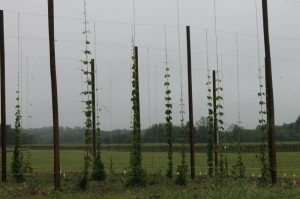

| Visitors Now: | |
| Total Visits: | |
| Total Stories: |

| Story Views | |
| Now: | |
| Last Hour: | |
| Last 24 Hours: | |
| Total: | |
How to Grow Hops at Home
Home-brewing is becoming a popular hobby for many enthusiasts. For most people, home brewing entails purchasing of dried hops. The truly savvy home brewers are learning how to grow hops at home.
Humulus lupulus is the scientific name for this perennial twining plant. The serious hobbyist wants to brew from the ground up. Growing hops is a great way to perfect the home-brewing process.
This gives brewers the most control over their ingredients. It’s also the perfect choice for anybody who wants to brew strictly organic beer. Many people regard the business of growing hops as somewhat mysterious.
Growing hops is actually pretty simple. As with any type of plant, there are certain factors to keep in mind before and during the growing process.
Step-By-Step Guide on How to Grow Hops at Home
- Climate Considerations and Soil
- When to Purchase Rhizomes
- Site Selection
- Support The Hops!
- Planting
- Hydration And Nutrition
- Handling Disease And Pests
- Harvesting
- Drying and Storage
- Enjoying The Fruits of Your Labor
- Climate Considerations and Soil
1. Climate Considerations and Soil
There are a few climate issues to take into account before jumping into the hop-growing season. First, there should be at least 120 frost-free days in the growing year. This is an absolute necessity for successfully growing hops.
The hop vines need to be able to grow flowers. The soil conditions should be well drained and fairly loamy. The hops will need lots of water, and the water needs to drain well. The pH needs to be between 6.5 and 8.0.
Hops also need nutrient-rich soil to grow well. Fertilizers that are high in potassium, nitrogen and phosphates are perfect. Manure compost and store-bought fertilizers are a good choice for most growers.
2. When to Purchase Rhizomes
Hops aren’t grown from seeds. They are grown from rhizomes. The rhizomes are typically only available in the spring. It’s important to contact a rhizome source before the growing season begins.
Often times, companies that sell rhizomes sell out quickly. With the popularity of home brewing growing, hops are becoming an in demand backyard crop. Additionally, these crops can vary from year to year.
It’s not uncommon for nurseries to have serious shortages in rhizomes. It may be necessary to pre-purchase or pre-order one’s rhizomes. Many nurseries will gladly add interested parties to an email newsletter list.
3. Site Selection
Hops do the best in an area with good southern exposure. If this isn’t possible, many gardeners can make an east or west facing area work. It’s important to note that for the best growth and largest cones, south facing sites are the best choice.
Direct sunlight is a must for healthy hops. The hops should also have plentiful access to water. Hop vines do very well along fence lines and walls. Gardeners should avoid areas with electrical lines, because vines can grow quite tall.
There should be at least 25 feet of vertical clearance in areas chosen for growing hops. Horizontal space shouldn’t be neglected either, since the roots will grow too.
4. Support The Hops!
Hop vines are also called bines by serious growers. These tall and heavy bines will need plenty of support while they grow. Many people like to plant their hops near a fence for support.
Stakes, trellises, lattice and poles are also great ways to support the hops as they grow. For the first year, hops probably won’t grow too large or heavy. Twine is also a helpful tool for support systems.
First time growers can connect twine from the ground to the top of a wall or pole. This is a cost-effective solution that doesn’t require a lot of manual labor.
It may be necessary to graduate to larger or sturdier support systems in the second or third growing years though. Lattice and trellises covered in hops actually look quite beautiful in the garden too.
5. Planting
The rhizomes can be planted vertically or horizontally in the ground. If the rhizomes are already starting to grow, it’s important to plant them with their buds pointing upward. They should be planted in shallow ground.
They only need to be covered by about one inch of soil. In most climates, planting should happen in the early spring time. Rhizomes shouldn’t be planted much later than early May.
It’s important to keep different varieties separated. Once the bines begin growing, it can be easy to lose track of what was planted where. It may help to plant labeling stakes in the ground as well.
6. Hydration and Nutrition
Adequate hydration is so important for new hops. They should never be dry for too long, but it’s also important for soil to have proper drainage. Mulch can help to retain a safe level of moisture between watering times.
The best way to water hops is to drench them, allow them to dry and then repeat the process. Some people find that a timer helps for this watering technique. Fertilizer should be added sparingly. Too much nitrogen can result in cones with a low alpha acid content.
7. Handling Diseases and Pests
Mildew is the hop grower’s enemy. Downy mildew is one of the most common types of mildew to ruin an otherwise beautiful and healthy crop of hops. Shoots may have a brittle or spiked appearance.
The leaves may begin to curl. The tops of the leaves will take on a silvery appearance, while the underside will turn black. Infected leaves need to be removed from the vine immediately.
Downy mildew typically occurs from too much moisture associated with drip irrigators. Wilt is another thing to look out for. Leaves will be dull green or yellow in color.
Equally important, the hop grower needs to be vigilant about bugs. There are organic options for killing a variety of pests in the garden.
8. Harvesting
Hops are typically ready to harvest in late August or September. The cones are ready when they begin to dry out a little. They will feel springy when squeezed. It’s also important to keep an eye on the yellow powder known as lupulin.
The hops will begin to emit that familiar strong smell too.
9. Drying and Storage
Hops should be dried immediately after the harvest. They can be spread out on drying screens and turned once each day. It usually takes a few days to dry the hops completely.
It’s important to keep them protected from bright light, bugs and high winds during this time. Some people use food dehydrators too. After drying, the hops can be safely stored in a cool, dark and dry area.
Glass jars and freezer bags are perfect for containing hops for storage.
10. Enjoying The Fruits of Your Labor
The process of learning how to grow hops at home is a fruitful one. Enjoying a delicious beer after a long growing and brewing season is satisfying. Friends will be impressed with the whole operation.
For many home brewers, it isn’t enough to just brew beer. Growing hops at home gives brewers the ultimate control over their beers. Brewing beer from home-grown organic hops is incredibly gratifying.
Growers will also be happy to learn that their crops will have higher yields in the following years. There’s something sacred about tending to the soil months before brewing one’s beer.
At the end of the season, the trials, tribulations and hard work of growing hops will culminate into a well deserved home brew.
Source: http://mikesbackyardnursery.com/2013/08/how-to-grow-hops-at-home/





Pretty much hops can be grown the same as cannabis. I have read the two can actually be grafted together. I’m not much of a beer drinker but I have a buddy who grows his own hops for home brew and he quiet enjoys it.